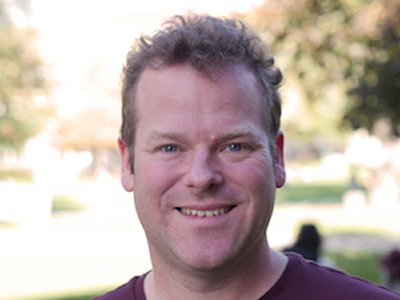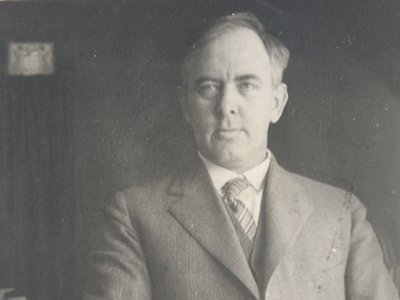Syracuse Physicist Named Brightman Endowed Professor
Duncan Brown lauded for excellence in gravitational wave astronomy

A physicist in Syracuse University’s College of Arts and Sciences is being recognized with a new endowed professorship.
Duncan Brown, a world-renowned expert in gravitational wave astronomy and astrophysics, has been named the inaugural Charles Brightman Endowed Professor of Physics. Brown is being lauded for his leadership role in the multinational Laser Interferometer Gravitational-Wave Observatory (LIGO) experiment, his excellence in teaching and mentoring, and his contributions to campus research computing.
The professorship is made possible by a $1.4 million bequest to the Department of Physics by Joseph and Charlotte ’37 Stone.
“Duncan epitomizes the tenacious, entrepreneurial spirit of Professor Brightman, who, during the 20th century, helped establish the University as a pioneer in physics teaching and research,” says Karin Ruhlandt, dean of A&S and Distinguished Professor of Chemistry. “I can’t think of anyone more deserving than Duncan, with his skill and sustained dedication in the classroom; his proven track record in scholarly and creative work; and his unwavering service to the global research community.”
The three-year professorship is designed to recognize and support early- to mid-career physicists.
A Syracuse faculty member since 2007, Brown studies gravitational waves—ripples in space-time that were predicted a century ago by Albert Einstein. The waves are so elusive that they have never been directly detected.
Brown specializes in ripples caused by the collision of black holes and neutron stars. With support from the National Science Foundation (NSF), he and his LIGO colleagues are searching for gravitational waves, in hopes of learning more about the Universe—from the nature of gravity to the properties of the atomic nucleus.
“Duncan is a leader in the search for gravitational waves, working at the nexus of physics, astronomy, and information studies,” says Alan Middleton, professor and chair of physics. “The University is a central contributor to this quest. A successful search would be historic: It would open up a new view of the Universe.”
In 1915, Einstein famously theorized that gravity is not a force, but a curvature of space-time. Middleton uses a common analogy to explain how mass distorts space-time.
“Matter and energy warp the space-time continuum,” he says. “A collision of two black holes is much like a bowling ball being dropped onto a mattress. Gravitational waves are ripples in the space-time continuum, like waves on a waterbed.”
A member of the LIGO Scientific Collaboration, Brown is part of a team of a thousand scientists from more than 50 countries. The professorship, Brown says, will be beneficial, whether he is working on campus or at one of the LIGO observatories in Washington State or Louisiana.
“I am honored to be selected as the first Brightman Endowed Professor,” says Brown, who earned a Ph.D. from the University of Wisconsin-Milwaukee. “This appointment will help push my teaching and research in new directions. It speaks volumes about Syracuse's commitment to the spirit of discovery.”
A Fellow of the American Physical Society, Brown is the recipient of an NSF CAREER Award, a Meredith Professor Teaching Recognition Award, and multiple department teaching awards. He also is a sought-after conference presenter; the principal investigator of more than a dozen sponsored research projects; and an accomplished teacher, mentor, and author.
"Duncan's career has been devoted to developing the most sensitive way to find elusive gravitational wave signals, hidden in LIGO's noise," says Peter Saulson, the Martin A. Pomerantz '37 Professor of Physics at Syracuse. "When gravitational waves are finally discovered, he will deserve a tremendous share of the credit."

The Brightman Endowed Professorship is named for the physicist who taught at Syracuse from 1916 to 1950. Brightman's teaching career also included stints at Wesleyan University; Mount Holyoke College; and DePauw University, where he was the first professor with a Ph.D. in physics (earned from Clark University in Worcester, Mass.). At DePauw, Brightman developed courses in modern theory and alternating current theory that were added to the curriculum.
Brightman’s daughter, Charlotte Stone, was an alumna of A&S and the S.I. Newhouse School of Public Communications. She and her husband, Joseph, gave generously to Syracuse over the years, also supporting the Tolley Humanities Distinguished Teaching Professorship in A&S and the Schine Student Center.
Charlotte was an accomplished magazine editor who died in 1997; Joseph, a Columbia professor-turned-metallurgical engineer passed away eight years later.
The Stone charitable trust provided income to care for various family members. When the last beneficiary died, Syracuse received the remaining principal.
Featured
Duncan Brown Vice President for Research, Syracuse University; Charles Brightman Endowed Professor of Physics
